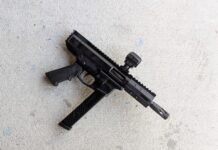
Threat appreciation is an intelligence term I first used in my infantry days. It is a term we combined with a S.A.L.U.T.E. report which covered the Size, Activity or Activities, Location, Unit (if observable), Time, and Equipment observed on a hostile or potentially hostile force. Was it a single person or a fireteam of three or four? Are they crossing open terrain or covertly entering a structure? Where? Are they uniformed forces or not? When? What did they bring with them?
It could also be used more generally for observations of locals to establish patterns of behavior, community size and structure, and any number of useful pieces of information so that decision makers can make better informed decisions about their actions in an area. These better informed decisions keep everyone in the unit safer, avoid antagonizing the locals more, and allow for much better effect against the hostile actors than just wandering around until they shoot at you or try and blow you up. Though sometimes the latter is all you can do.
Threat Misappreciation
Originally this post was a bit of a rant against so titled ‘Israeli Carry’ or empty-chamber carry of a self defense sidearm. Where people will have a magazine in the weapon but no round in the chamber, instead relying on their ability to pull the weapon and properly chamber a round while in a fight at contact distances. This often assumes you will have unimpeded use of both arms, both hands, and that nothing will go wrong in the complex mechanical steps of chambering a round manually. Manually chambering a round is, by the way, the act we check on the most and spend the most time seeing to getting right in loading procedures. A chamber check or press check and then making certain every aspect of the pistol is ready to go, including optic and light (where applicable) before going about the next task. It is not a hurried task, it is an administrative one that spending enough time on is the prudent course.
Why on earth would you want to turn that process into an emergency step?
The general consensus is that empty chamber carry is a bad idea. I concur with the consensus, you are placing too many steps between accessing the emergency tool and being able to put it into use. This can easily result in an injurious failure to use the weapon in time to be effective, arm an aggressor, or lose your life. It isn’t as ‘talisman’ as carrying or having an empty gun, but it is close.
I liken empty chamber carry to a fire extinguisher (hence the photo) in that there are several steps you must take in order to bring the fire extinguisher to action on a fire. In parallel, with an empty pistol there are several steps you must take to bring the pistol to action against a lethal threat.
Fire is a real threat, we have departments and equipment dedicated to its control and stoppage, we run drills to remove ourselves from its area, and we mandatorily place extinguishers to fight appropriately sized fires. It is that final part of the threat that gets lost. Once a fire gets beyond what could be safely called ‘small’ it isn’t an extinguisher level job anymore and instead of breaking glass to chemically starve the blaze you should be moving away from it, quickly. If said fire is consuming a hallway and running (burning) towards you at an overwhelming pace (instead of just burning on a stove top, under a car hood, or some other fairly small, contained, and static location) you don’t fight that fire… you flee.
What I am getting at is the threat appreciation of a fire where a fire extinguisher is a viable counter is select. It offers a responder some time and some space to prepare and react. The fire is not chasing you, it is not a targeted threat against you, it is an environmental hazard that is dangerous, but it is only chasing fuel to keep burning.
Fire therefore is a different threat than an assailant, because an assailant is chasing you, pursing you, invading your house, threatening your life specifically. The assailant is an intelligent threat with will and decision making capacity (even if its an animal like a dog, big cat, or bear), while a fire is a mindless environmental hazard without will, instinct, or malice.
Because the threats are different, the countermeasures should be treated differently. Against a threat with any reasoning capacity, instinctual or higher cognitive, we need an ‘extinguisher’ that can work more rapidly. That works inside that threats ability to harm us. That means we need less steps to bring it into action than something predictable and not actively hunting you, like a fire.
Different threats, different reaction time requirements, different responses, and differently prepared emergency tools.
Threat Misrepresentation
‘Israeli Carry’ is an example of threat misappreciaiton, meaning someone followed a flawed logic chain by not considering certain factors like reaction time but came to an otherwise sound conclusion for the chain they followed. This happens all the time.
Something else that occurs is threat misrepresentation, which is a failure to consider a threat’s true equivalency often due to an emotional investiture of some form.
Here’s a prime example,

“That’s completely different” was an argument I once heard from a Frenchwoman who stated they had no such epidemic of violence there as we did here. Which was true, from a certain point of view…
In response I pulled up a story from earlier that very month where criminals engaged police and bystanders with automatic weapons (yes, full blown machine guns), several were killed an injured. “That’s completely different, those were criminals,” was the response I received. It is an absurd response on the face of it, but I knew what she meant.
Firstly, she classified any violence associated with organized criminal elements (the event was a robbery) as different than the perception of ‘at random’ street violence happening on every corner of America. She was emotionally invested in the difference as well, she ‘knew‘ France was more peaceful and safe than the United States and that the shootings where therefore “completely different” events.
We do know better, most of the United States’ gun violence can also be linked to organized criminal groups. The next largest category usual falls under domestic violence categories, the offender and victim(s) have a connection and association tied to a triggering event. France has one of the highest domestic violence rates in the EU by the way. It also has the second highest homicide rate in Western Europe, they aren’t immune from violence by any stretch.
Secondly, she was more invested in being correct about her emotionally invested position than in testing to see if that position stood up to scrutiny. She was willing to use an loose association of facts to do so, namely that France had a lower homicide rate than the USA. Some context applied when it supported her emotionally held position and context was disregarded when it didn’t, such as the fact most of the US gun violence can be linked to criminal organizations and associations. Gangs, organized criminal elements, are comparable worldwide.
That same misrepresentation of events is on display in the text exchange. “Why do you need an AR-15?” is an interrogative asked by somebody who already ‘knows’ that you don’t, and they are emotionally invested in that answer. In a politician’s case, they might be financially and electively invested in the answer as well. Logic is not the only force in play.

Misappreciation vs. Misrepresentation
In my observation, misappreciation comes from elements who likely agree with you or I, or are at the least open minded to the facts and circumstance of considering a threat.
Misrepresentation comes from elements passively and actively hostile to your position due to emotional investment in their position.
It comes back to the fact that people are human and we can expect them to act like humans, and emotional investment is the most human of traits. Understanding that can better help you impress upon an inquirer why their position might be underinformed, and thus was formed incorrectly with bad or outdated information.
Nobody likes to hear that they are ‘wrong’ however more people are open to, “but did you consider?”



